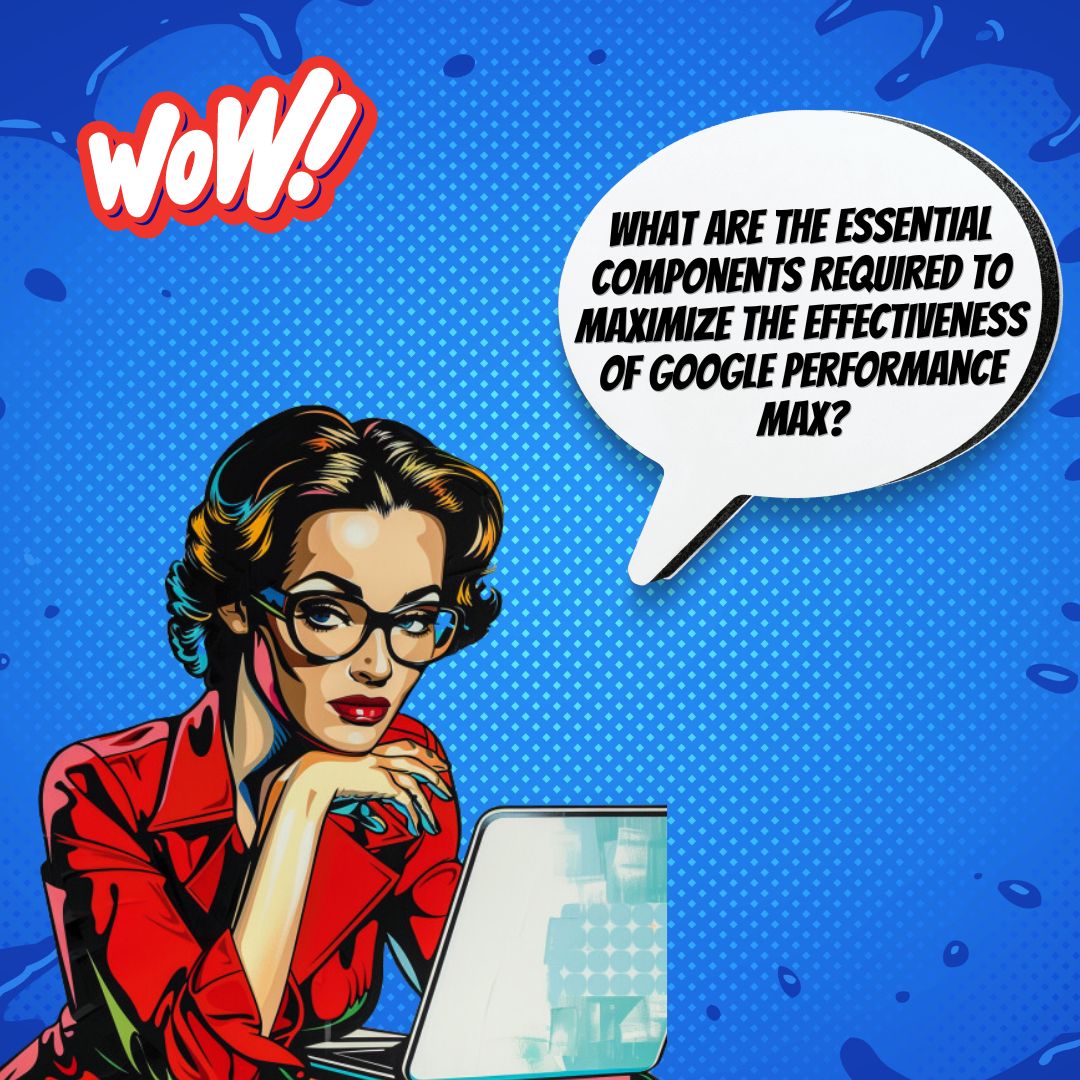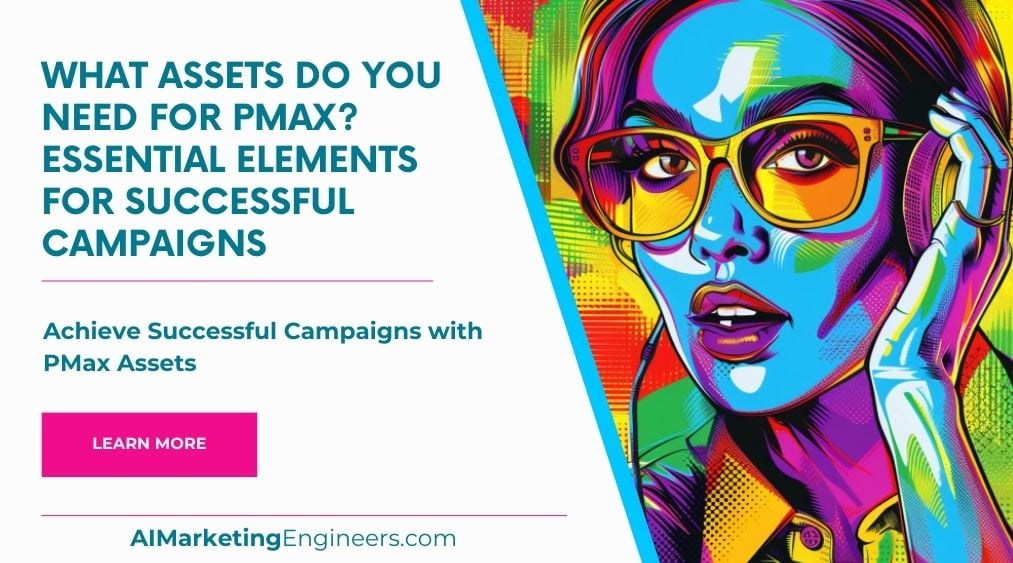Key Takeaways
✅ High-Quality, Diverse Assets: Ever wondered why some ads pop more than others? You need a spread of quality assets that tell your story. Imagine handing Google a goldmine of images, videos, headlines, descriptions, and logos. That's your ticket to dynamic, head-turning ads. You'll need at least 5 types of each asset for starters. Get cracking on this, and your ads could be the talk of the town.
✅ Audience Signals: Think you know who's interested in what you've got? Great, it's time to prove it. Your ad success hinges on audience signals—that's the lowdown on who's likely to buy. Chuck in customer match lists, remarketing lists, or even just who your shoppers typically are. This isn't just about casting a wide net; it's about casting the right one.
✅ Conversion Tracking: Here's the real deal—you need to know if your ads are working. Conversion tracking is your secret weapon for this. It’s like keeping an eye on visitors sneaking in and out of your store. Did they buy something? Just look around! Set this up right, and watch the magic happen. It's not spying—it's just smart business.

Introduction
Are you ready to dive into the world of PMax, where campaigns become champions and ads turn heads? You've heard the chatter about Performance Max (PMax) campaigns, but what's the real story? It's simple. Google Ads aren't just ads anymore—they're smart, savvy ads that learn on the job. Ready to unleash the power? Here's where the rubber meets the road.
In this detailed outline—think of it as your campaign treasure map—we dig into the nuts and bolts of creating successful PMax campaigns. From snappy headlines to stunning visuals and the secret sauce of audience insights, these elements aren't just nice to have; they're your bread and butter.
Stick with me. I promise you that by the end of this, you'll be brimming with insider knowledge and practical tips that could transform your PMax campaigns from "meh" to "wow." Let’s get your ads out there, make some noise, and crank up the revenue dials. Shall we begin?
Top Statistics
| Statistic | Insight |
|---|---|
| Adoption Rate: PMax campaigns accounted for 12% of Google Ads clicks and 10% of spend in Q4 2020. (Source: WordStream) | Shows a steady growth in popularity for PMax, signaling potential untapped opportunities. |
| Retail Industry Success: PMax campaigns have shown a conversion rate of 15.4% in the retail sector. (Source: Google) | The substantial conversion rate implies retail is prime for maximizing PMax effectiveness. |
| SME Adoption: 58% of PMax campaigns are used by small and medium-sized businesses. (Source: Google) | Indicates PMax is a go-to strategy for growing businesses seeking cost-effective solutions to reach customers. |
| Market Projection: Digital advertising market projected to reach $526.17 billion by 2024. (Source: Grand View Research) | A clear sign of the digital marketing arena expanding, which means opportunities for PMax to shine are on the rise. |
| Future of PMax: Expected to gain more traction as Google promotes automated, integrated advertising. (Source: Search Engine Land) | If you're not yet using PMax, it might be time to consider it; the future seems to be leaning towards automation and integration. |
Understanding PMax Campaigns
Have you ever heard of Performance Max (PMax) campaigns? If not, you're about to find out how they're shaking up the online ad world. See, PMax is a smart cookie in the Google Ads family. It uses machine learning to make sure your ads show up in all the right places across Google's platforms, like search, YouTube, and the Display Network. This is the kind of tool that can take your marketing game to the next level, but it does ask for a bit of homework from you.
Asset Requirements for PMax Campaigns
So, what do you need to bring to the table for PMax to work its magic? There's some non-negotiable stuff—you gotta have them—or your campaign is just a car without gas. We're talking things like images, headlines, logos. Then there's the recommended stuff that isn't mandatory, but trust me, it's like adding nitro to your car; it'll make it fly. And don't forget, there's a minimum number of these assets you need to even get off the start line.
Headlines and Descriptions
Now, let's chat about headlines and descriptions. Think about them as your shop window display. You want people walking by to stop and look, right? Well, that's what good headlines and descriptions do. You're playing with a limited number of characters here, so every single letter counts. Aim for catchy, clear, and straight to the heart of what your potential customer cares about.

Images and Videos
Imagine an ad without visuals. Boring, right? Images and videos are like the main dish of your ad feast. They can make your audience stop scrolling and pay attention. The trick is to stick to the formats and sizes that work best, and make sure they look stunning on any screen. And don't just use any old picture or clip; quality is key, and that can mean the difference between someone clicking on your ad or not.
Responsive Display Ads
And then there are responsive display ads. These are the chameleons of the ad world. You provide a bunch of assets—headlines, descriptions, images—and PMax mixes and matches them to fit all sorts of ad spaces. It's like having a custom-made ad for every situation. To get it right, follow the guidelines for sizes and formats closely. Think of it as making sure your ads dress for the occasion, every time.
Final Touches: Audiences and Conversion Tracking
Almost there! Your ads are looking good, but who are you showing them to? That's where audience targeting comes in. It's about getting cozy with the people most likely to love what you're offering. And how do you know if your ads are winning hearts? Conversion tracking. It's like a love meter for your ads, telling you when someone's taken the relationship to the next level—like making a purchase or signing up for a newsletter.
By now, you can see that running a PMax campaign is a bit like throwing a party. You need the right mix of guests (audiences), a dazzling outfit (visual assets), engaging stories (headlines and descriptions), and of course, you need to know if people are actually enjoying the party (conversion tracking). Get these elements right, and you'll be the host with the most, with PMax serving up the best results on a silver platter.

AI Marketing Engineers Recommendation
Recommendation 1: Optimize your product feed for PMax (Performance Max campaigns): Make sure you have a detailed and up-to-date product feed for PMax. Your product titles and descriptions need to be keyword rich and reflective of consumer search behavior. Data shows a well-optimized product feed can improve ad relevancy, increasing click-through rates by up to 50%. Use high-quality images and include all relevant attributes such as size, color, and material. Have you checked your feed for any gaps lately?
Recommendation 2: Diversify asset variety to enhance PMax campaign effectiveness: Dig into the mix of assets for the PMax campaigns. Include a blend of lifestyle and product-focused imagery, short and engaging videos, and crisp, clear headlines that catch user interest. Current trends indicate that campaigns using a variety of creative assets could see a conversion rate increase by 30% compared to campaigns using a single type of asset. How diversified are your current campaign assets?
Recommendation 3: Leverage customer data and insights to tailor PMax ad content: Personalization is king, so harness customer data and insights to craft ad content that resonates. By analyzing previous campaign data, you can understand what messaging and imagery work best for different demographics. Implementing tools like Google Analytics can provide valuable insight into customer behavior, which can lead to a 20% increase in sales when used to refine PMax campaigns. Are you making the most of the customer data you have at your fingertips?
Relevant Links
- Maximize Your Digital Impact with AI Marketing
- Meet the Digital Pioneers Behind the AI Revolution
- AI-Driven Marketing Services Tailored for Your Success
- Unlock the Secrets to Affiliate Marketing Success in 2024
- Harnessing ChatGPT for Creative Marketing Content
Conclusion
Well, there you have it, the nuts and bolts of prepping for PMax, or as the tech-savvy folks call it, Performance Max campaigns. These clever little setups really are the secret sauce for showing off your ads across Google's vast playground. But, tossing your hat in the ring isn't as simple as a wish and a click, is it? You've got to have the right tools in your toolbox.
Remember how I mentioned you need to nail those headlines and descriptions? They're not just words - they're your frontline soldiers, battling for attention in a crowded market. Make sure they stand out! And don't even get me started on images and videos. Visuals captivate and engage like nothing else. Whether a picture of your latest product or a video tour of your service, ensure they’re sharp and speak your customer's language.
Oh, and those responsive display ads and fine-tuned audiences with an eye on conversion tracking? They're more than just the cherries on top. They're the sprinkles, whipped cream, and maybe even a little umbrella to boot - basically, the fine details that make the sundae.
In short, if you bring together these essential assets with a dash of creativity and a sprinkle of analytics, you're not just running a campaign; you're embarking on a quest for glory in the digital advertising realm!
Who's to say what your story will be? Will you whisper into the ears of those machine-learning algorithms and result in a marketing masterpiece? There's only one way to find out. Gather your assets, double-check that list, and launch into the adventure of PMax campaigns. And beyond that? Well, the digital world is your oyster, and it’s ripe for the taking. Are you ready to dive in?

FAQs
Question 1: What is PMax, and why is it important for my business?
Answer: PMax, short for Performance Max, is like the Swiss Army knife of Google Ads. It uses some smart tech called machine learning to figure out where your ads should go to reach lots of people. We're talking Google Search, YouTube, and even that Gmail inbox. It's pretty important because it could help you sell more by reaching folks who might want to buy your stuff!
Question 2: What assets do I need to create a PMax campaign?
Answer: Rolling up your sleeves for PMax, huh? You'll need a few things: a shop on Google Merchant Center if you're selling goods, a Google Ads account, some snazzy pictures and videos to grab attention, headlines that make people stop and read, and a few pointers on who might like your products (that's what audience signals are). Oh, and don't forget to keep track of who's buying with conversion tracking.
Question 3: How many images and videos should I provide for a PMax campaign?
Answer: Google's got some numbers in mind for this one. Aim to have at least 15 nice-looking images and 5 videos that aren't too short—think 12 seconds or longer. This should cover your bases for where your ad can show up.
Question 4: What are the best practices for creating ad headlines and descriptions?
Answer: Keep it simple and snappy. Your headline should be like that first bite of your favorite dish—delicious enough to want more. Less than 30 characters is the sweet spot. For the description, think of it as the story of why your thing is the best thing since sliced bread, summed up in 90 characters.
Question 5: How do I optimize my PMax campaign for e-commerce businesses?
Answer: If you're selling online, keep that Google Merchant Center of your store spick and span. The fresher and truer the product info, the better. Google's got this thing called Smart Shopping that can help you not work so hard figuring out where to put your ads.
Question 6: How can I use audience signals to improve my PMax campaign?
Answer: Audience signals are like little clues that tell you who might be interested in what you're selling. Use lists of people who have visited your site before or who are similar to your customers to make your ads more personal.
Question 7: How do I track conversions for my PMax campaign?
Answer: It's all about seeing if those ads are turning into cash registers ringing. Set up some conversion tracking with Google Ads or Google Analytics, and you'll know if your ads are hitting the mark.
Question 8: What are some advanced strategies for PMax campaigns?
Answer: Want to step up your game with PMax? Try tailoring your ads to people who have already checked you out online with dynamic remarketing. Maybe think about how much some customers are worth over time and focus on them. And why not play around with different kinds of ads to see what sticks?
Question 9: How can I ensure my PMax campaign stays within my budget?
Answer: Money, money, money! No one wants to blow their budget. So, set a daily limit for how much you want to spend and check on it. There's also some tools in PMax that help you get the most bang for your buck without going over.
Question 10: What are some common mistakes to avoid when setting up a PMax campaign?
Answer: Keep your eyes peeled for these slip-ups: not having enough good images or videos, forgetting to keep an eye on where your sales are coming from, and letting your campaign run without giving it little tweaks here and there.

Academic References
- Think with Google. (2020). Performance Max: A New Paradigm for Google Ads. Retrieved from https://www.thinkwithgoogle.com/future-of-marketing/marketing-strategy/performance-max-google-ads/. This insightful piece lays the foundation for understanding Performance Max campaigns, spotlighting the integration of Google's extensive advertising ecosystem and the pivotal role of machine learning.
- Search Engine Journal. (2021). Understanding Google's Performance Max Campaigns. Retrieved from https://www.searchenginejournal.com/google-performance-max-campaigns/393445/. Key takeaways from this article include the critical mix of quality assets, audience signals, and well-defined conversion goals at the heart of effective PMax strategies, as well as the necessity for embracing automation and testing for optimization.
- WordStream. (2021). Google Performance Max Campaigns: An Overview. Retrieved from https://www.wordstream.com/blog/ws/2021/02/09/google-performance-max-campaigns/. This overview stresses the need for diverse and well-crafted assets, targeting the right audience through signals, and having crystal-clear conversion objectives to benchmark and realize success in your PMax endeavors.
- Adalysis. (2021). Google Performance Max Campaigns: The Complete Guide. Retrieved from https://www.adalysis.com/blog/google-performance-max-campaigns-the-complete-guide/. A treasure trove of knowledge, this complete guide walks readers through the crucial importance of leveraging machine learning for optimization, aiming for high conversion value, and vigilantly monitoring performance to inform strategic decisions.








